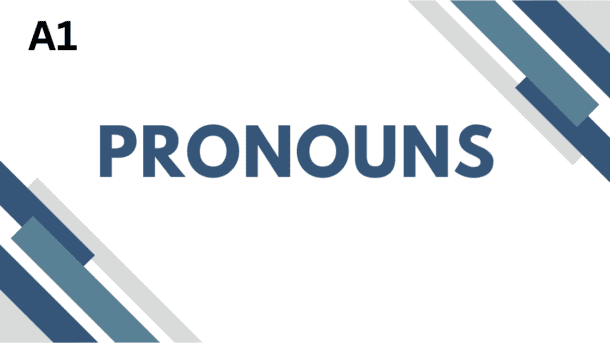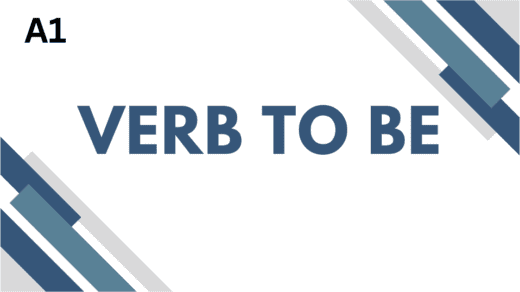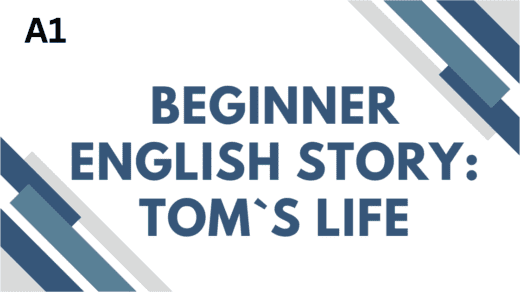What are Pronouns?
Pronouns are words that substitute for nouns in sentences. Their main purpose is to avoid repetition and make sentences easier to read and understand. There are several categories of pronouns, each serving different functions.
| Subject pronoun | Object pronoun | Possessive adjective (determiner) | Possessive pronoun | Reflexive or intensive pronoun | |
|---|---|---|---|---|---|
| 1st person singular | I | me | my | mine | myself |
| 2nd person singular | you | you | your | yours | yourself |
| 3rd person singular, male | he | him | his | his | himself |
| 3rd person singular, female | she | her | her | hers | herself |
| 3rd person singular, neutral | it | it | its | itself | |
| 1st person plural | we | us | our | ours | ourselves |
| 2nd person plural | you | you | your | yours | yourselves |
| 3rd person plural | they | them | their | theirs | themselves |
Types of Pronoun:
1. Personal Pronouns
Personal pronouns refer to specific persons or things and can be categorized into subjective and objective forms.
Subjective Personal Pronouns:
These are used as the subject of a sentence.
Pronoun Forms:
- I: Refers to the speaker. Example: “I love reading.”
- You: Refers to the person or people being addressed. Example: “You are invited to the party.”
- He: Refers to a male individual. Example: “He plays guitar.”
- She: Refers to a female individual. Example: “She is a talented artist.”
- It: Used for objects, animals, or ideas when the gender is not specified. Example: “It is raining.”
- We: Refers to the speaker and at least one other person. Example: “We are going to the beach.”
- They: Refers to a group of people or things. Example: “They are studying for the exam.”
More Example Sentences:
- I: “I enjoy reading.”
- You: “You are my best friend.”
- He: “He plays soccer every weekend.”
- She: “She loves to paint.”
- It: “It is raining today.”
- We: “We are going to the concert.”
- They: “They have completed their project.”
Objective Personal Pronouns:
Objective personal pronouns are used as the object of a verb or a preposition, replacing the noun that receives the action in a sentence. The objective personal pronouns in English are: me, you, him, her, it, us, and them. Here are some examples of their usage:
- Me: Look at me.
- You: I’ll talk to you later.
- Him: Jane is with him.
- Her: I will help her with the project.
- It: Use it to fix the problem.
- Us: They invited us to the party.
- Them: I met them at the café.
Common Errors:
**Choosing the correct pronoun form is important based on its grammatical role. Many speakers often confuse subjective and objective pronouns, such as saying “me and John went to the store” instead of “John and I went to the store.”
In summary, objective personal pronouns are critical elements used to indicate who is receiving the action in a sentence, either directly or indirectly, or who is being referenced about a preposition. Proper use enhances sentence clarity and grammatical accuracy.
2. Possessive Pronouns
Possessive pronouns indicate ownership or possession and stand in place of a noun to show that something belongs to someone. The primary possessive pronouns in English are: mine, yours, his, hers, its, ours, and theirs. Unlike possessive adjectives (my, your, his, her, its, our, their), which are used before nouns, possessive pronouns can stand alone.
- Mine: Indicates that something belongs to the speaker. For example: “This book is mine.”
- Yours: Indicates that something belongs to the person being spoken to. For example: “Is this pen yours?”
- His: Indicates possession by a male person. For example: “That backpack is his.”
- Hers: Indicates possession by a female person. For example: “This sweater is hers.”
- Its: Used for non-human subjects to denote possession. For example: “The cat licked its paws.”
- Ours: Indicates that something belongs to the speaker and one or more others. For example: “That house is ours.”
- Theirs: Indicates that something belongs to a group of people. For example: “The decision is theirs.”
More Example Sentences:
- Mine: This book is mine.
- Yours: Is this pen yours?
- His: That car over there is his.
- Hers: The blue sweater is hers.
- Its: The company has its policies (often used for non-living entities).
- Ours: The house next door is ours.
- Theirs: The children are playing with their toys; those are theirs
3. Reflexive Pronouns
Reflexive pronouns are a specific type of pronoun used to refer back to the subject of the sentence, indicating that the subject and the object of the verb are the same person or group. They are typically formed by adding “self” or “selves” to personal pronouns. The list of reflexive pronouns includes: myself, yourself, himself, herself, itself, ourselves, yourselves, themselves.
- myself (for “I”)
- yourself (for “you” – singular)
- himself (for “he”)
- herself (for “she”)
- itself (for “it”)
- ourselves (for “we”)
- yourselves (for “you” – plural)
- themselves (for “they”)
Example Sentences:
- I cut myself while cooking.
- She taught herself how to play the piano.
- He finished the project by himself.
- The cat groomed itself.
- We enjoyed ourselves at the party.
- You should treat yourselves to a nice dinner.
- They prepared everything for themselves.
4. Demonstrative Pronouns
Demonstrative pronouns are used to point to specific things or people. this, that, these, those
- This: Used for singular nouns that are close in distance or time. For example, “This is my book.” Here, “this” refers to a specific book that is near the speaker.
- That: Used for singular nouns that are farther away in distance or time. For instance, “That is the house I grew up in.” “That” points to a specific house that is not immediately close to the speaker.
- These: The plural form of “this,” used for more than one item that is near. For example, “These are my friends.” “These” implies that the friends are physically close to the speaker.
- Those: The plural form of “that,” used for multiple items that are farther away. For example, “Those are over there.” “Those” indicates a group of people or things that are not close to the speaker.
More Example Sentences:
- This: Used for a singular noun that is nearby.
- Example: “This is my favorite mug.”
- That: Used for a singular noun that is farther away.
- Example: “That was an amazing concert last night.”
- These: Used for plural nouns that are nearby.
- Example: “These are the books I borrowed from the library.”
- Those: Used for plural nouns that are farther away.
- Example: “Those were the best days of my life.”
Demonstrative pronouns can also indicate time, as in “This week is busy for me,” or “That day was unforgettable.” They serve to clarify which specific noun is being referred to in a conversation, which is crucial for effective communication. When using demonstrative pronouns, context is key, as they rely on the listener’s understanding of what is being referred to based on the situational context or previous conversation.
5. Interrogative Pronouns
Interrogative pronouns are used to ask questions and typically include “who,” “whom,” “whose,” “what,” and “which.” Each pronoun has a specific function:
- Who: This pronoun is used to inquire about the identity of a person or people. For example, “Who is coming to the party?” Here, “who” seeks to identify a participant.
- Whom: Traditionally used as the object of a verb or preposition, “whom” is less common in everyday speech but still correct in formal contexts. For example, “To whom did you give the book?” In this sentence, “whom” refers to the recipient of the book.
- Whose: This interrogative pronoun expresses ownership or possession. For example, “Whose jacket is this?” Here, “whose” is used to ask about the owner of the jacket.
- What: This pronoun is used to inquire about things or information that is not person-specific. For instance, “What are you doing?” This question seeks information about an action or event.
- Which: This is used to ask about a specific item or option from a defined set. For example, “Which movie do you want to watch?” In this case, “which” helps narrow down the choices.
more examples sentences:
- Who ate my sandwich?
- Which color is your favorite?
- What is the capital of France?
- Whom did you see at the party last night?
- What is the meaning of life?
Interrogative pronouns can function in various sentence structures and can be complemented with additional words to form more complex questions. For example, “What time are we meeting?” and “Who do you think will win the election?” They are crucial in facilitating communication by helping speakers gather information. Understanding and using interrogative pronouns correctly enhances clarity in inquiry.
Effective tips for studying types of pronoun:
- Understand the Types: Familiarize yourself with the different categories of pronouns (personal, possessive, reflexive, demonstrative, interrogative, relative, and indefinite) and their functions to build a solid foundation.
- Use Examples: Create or find example sentences for each type of pronoun to see them in context. This helps you understand how they replace nouns and the nuances of their usage.
- Practice with Exercises: Engage in exercises or quizzes that focus specifically on pronouns. Fill-in-the-blank activities, matching, and sentence correction can reinforce your learning.
- Use Flashcards: Create flashcards with different pronouns on one side and their meanings or usage on the other. Regular review can help commit them to memory.
- Read Aloud: Reading sentences or passages aloud that contain various pronouns can improve your recognition and understanding of their function in context.
- Write Sentences: Practice writing your own sentences or short paragraphs using different pronouns. This enhances your ability to use them accurately and creatively.
- Review and Edit: Go through your written work and identify pronouns, checking for correct usage. This helps reinforce your understanding through active reflection.
- Watch Videos: Utilize online resources, such as videos or educational websites, that explain pronouns through visual and auditory methods to cater to different learning styles.
- Stay Consistent: Set aside regular study time specifically for practicing pronouns, ensuring you revisit them consistently to solidify your understanding over time.
By using these tips, you can enhance your grasp of pronouns and improve your overall fluency in English.
Conclusion
Pronouns play a vital role in English by replacing nouns to prevent repetition and enhance clarity. Understanding their various types, forms, and uses is essential for effective communication in both writing and speaking. Remember that the pronoun you choose must agree with the noun it replaces in number (singular vs. plural) and gender (masculine, feminine, or neutral) when applicable.




